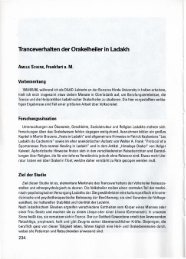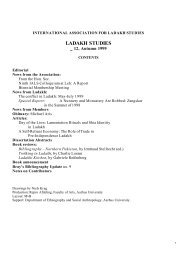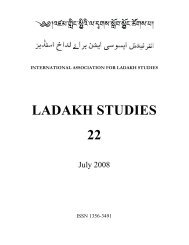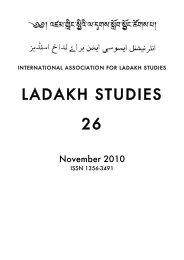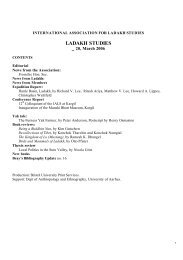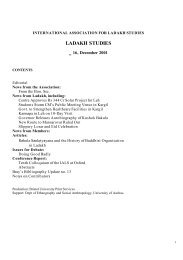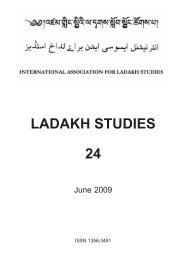LADAKH STUDIES 14, Autumn 2000 - International Association for ...
LADAKH STUDIES 14, Autumn 2000 - International Association for ...
LADAKH STUDIES 14, Autumn 2000 - International Association for ...
Create successful ePaper yourself
Turn your PDF publications into a flip-book with our unique Google optimized e-Paper software.
Commissioner in the late 1880s. These are to be found in the India Office archives in London, and<br />
there are presumably duplicates in the National Archives of India. Ramsay’s correspondence is<br />
discussed in an article on the Lopchak by this reviewer in the Tibet Journal (Vol. 15, No.4 - Winter<br />
1990). Ramsay argued that the Lopchak implied that Ladakh was somehow subservient to Tibet, and<br />
that it should there<strong>for</strong>e be abolished. Although, his proposal was rejected, his testimony is a valuable<br />
source on the state of the Lopchak at the time when he was writing. Rizvi more than makes up <strong>for</strong><br />
this omission with evidence from other documentary sources, as well as surviving participants of the<br />
Ladakh/Tibet trade. One of the most valuable aspects of this chapter is the clear explanation of the<br />
role of leading Leh families in both Ladakh and Tibet.<br />
The Karakoram trade was even more politically sensitive than the Lhasa route. In the midnineteenth<br />
century the British feared that the Karakoram pass might be a potential Russian invasion<br />
route. This concern, combined with the hope of selling British and Indian products in the markets of<br />
Central Asia, led to the establishment of a <strong>for</strong>mal agreement with Kashmir on the maintenance of<br />
the ‘Treaty Road’ from Kashmir to Ladakh and Xinjiang. In practice, political upheavals in Central<br />
Asia, and the physical difficulties of the journey, limited the prospects <strong>for</strong> commercial expansion.<br />
However, the trade played an important part in the economy and culture of Ladakh until the early<br />
1940s.<br />
Rizvi’s particular achievement is the skilful combination of documentary research with<br />
evidence gathered from interviewing more than a hundred elderly survivors. Her historical analysis<br />
is thorough, but the most distinctive—and irreplaceable—aspect of the book is the personal<br />
testimony of her human in<strong>for</strong>mants. No one can understand Ladakh’s history without considering its<br />
trading relations. No one can now af<strong>for</strong>d to speak or write about Ladakhi trade without first reading<br />
this book<br />
John Bray<br />
37




